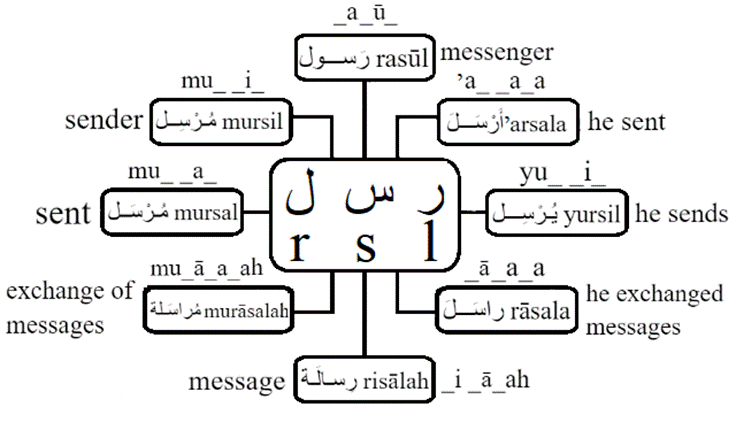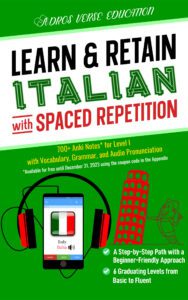Most words in Arabic can be traced to a tri-consonantal root, consisting of three consonants, called radicals, used to form word patterns. Only a few words can be traced to roots with two or four radicals. This is a characteristic feature of Arabic and other Semitic languages, such as Amharic, Hebrew, and Aramaic.
In a consonantal root system, consonants are the main carriers of meaning, whereas vowels, prefixes, suffixes, infixes, etc., modify that meaning while maintaining the relationship with the original meaning implied by the consonantal root.
Let us explain that with an example.
Take the consonantal root ك – ت – ب (k – t – b), which is used to derive the following words:
| _ a _ a _ a | كَــتَـبَ | kataba | he wrote |
| ya _ _ u _ u | يَـكْــتُـبُ | yaktubu | he writes |
| _ i _ ā _ | كِــتـاب | kitāb | book |
| _ u _ u _ | كُــتُـب | kutub | books |
| ma _ _ a _ | مَـكْــتَـب | maktab | desk/office |
| ma _ _ ū _ | مَـكْــتـوب | maktūb | written |
| _ ā_i_ | كــاتِـب | kātib | writer |
Notice how words derived from the same consonantal root share related meanings. For instance, a “book” is something that is written, whereas an “office” is where the writing occurs. This is how word derivation works in Arabic.
Here is another example of words derived from the consonantal root ر – س – ل (r – s – l):

Finding the root of a word is not always straightforward. It requires practice and a deep understanding of the language’s intricacies. Determining the consonantal root is also crucial when using a traditional Arabic dictionary. In Arabic, unlike in English, words are searched using their consonantal roots rather than their alphabetical order in a dictionary. For example, to search for the word مَـكْــتـوب (maktūb) ‘written’ in Arabic, you will need to search for the root ك – ت – ب (k – t – b).
Arab grammarians use the tri-consonantal root ف – ع – ل (f – ‘ – l) as the template upon which all Arabic word patterns are molded. The simplest verb derived from this root is فَــعَـل (fa‘āla), meaning “he did or acted.” Note that the simplest verb form, i.e., the basic verb form, in Arabic is the third-person singular masculine past tense.
For example, the word إِسْــلام (’islām) ‘Islam’ is derived from the consonantal root س – ل – م (s – l – m). Thus, we conclude that the word إِسْــلام (’islām) ‘Islam’ follows the pattern (’i◌◌ā◌). The literal meaning of the word Islam is submission, referring to the act of submission to God. By recognizing that the consonantal root is س – ل – م (s – l – m), we deduce that the word إِسْــلام (’islām) ‘Islam’ follows the pattern إِفْــعـال (’if ‘āl).

Another word derived from the consonantal root س – ل – م (s – l – m) is the noun سَــلام (salām) ‘peace.’ By following the same exercise, we deduce that the word سَــلام (salām) ‘peace’ follows the pattern فَــعـال(fa‘āl).

Notice that there are often many patterns available to derive words from a consonantal root. Some of these patterns are used, whereas others are not used by native speakers today or may have been used historically but are no longer in use.
Let us continue with the consonantal root س – ل – م (s – l – m) and consider the most common possible present verb patterns in the third-person singular masculine form from the consonantal root س – ل – م (s – l – m).
The ten most common present verb patterns in Arabic are:

By replacing the radicals in the template root ف – ع – ل (f – ‘ – l) with the radicals س – ل – م (s – l – m), we derive the following verbs:

Notice the variety of meanings conveyed by the patterns and their relationships. Sometimes the relationship can be logical—for example, submitting or surrendering to attain peace. However, the meaning can sometimes deviate, making the relationship vague or obscure. This process of unraveling the root derivation and the evolution of meaning is an intriguing feature of Arabic. Additionally, note that some of these patterns may not apply to certain consonantal roots.
It is important to be able to recognize the root of a word for many reasons. First, only by recognizing the consonantal root of a word can you access a traditional Arabic dictionary. For more complicated words, this may take a few educated guesses. Second, many word patterns appear in verb conjugation and other derivations, such as irregular plural formation, diminutives, etc., which can help you recognize and form new words as you learn Arabic.
Next: Introduction to Grammatical Cases
Other lessons in Level II:









